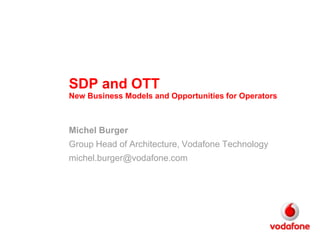Sdp summit
- 1. SDP and OTTNew Business Models and Opportunities for OperatorsMichel BurgerGroup Head of Architecture, Vodafone Technologymichel.burger@vodafone.com
- 2. A World of API
- 4. Today API Cloud12secondstv 23 30Boxes 411Sync 43Things 5min 7digital A9 Abbreviations Active AddThisMenuAddThisSharingEndpointsAdobeOnAirAdobeShareAdobeSocialAevumObscurumAftertheDeadlineAgentRankaideRSS AIM AIMPhonelineAkismetAlcatelLucentOpen Alchemy AlchemyAPIKeywordandTermExtractiAlexaAlexaThumbnailAlexaTopSitesAlexaWebInfoAlternativeTo Amazon AmazonCloudWatch AmazonEC2 AmazonFulfillmentWebServiceAmazonHistoricalAmazonMarketplaceWebServiceAmazonPaymentsAmazonQueueAmazonRDSRelationalDatabaseServi AmazonS3 AmazonSimpleDB AMEE Amplify AOLOpenAuthAOLOpenMailAOLPicturesAOLVideoAOLVideoUploadAOLWebAIMAonawareDictionaryArcWebArtBeatarXivAustralianBusinessNumberLookupAuthenticJobsAuthorize.NetAvantLinkAvvoAwesmBabyNames Backpack BackTweetsBackTypeBandsintown Basecamp BatchBook BBC BBCMusicBeboBeenVerifiedBeerMappingBeliefNetworksBestBuyRemixBetfairBibleGatewayBibSonomyBigHugeThesaurusBigTribe Billboard Billomat Bing BingMaps Bit.ly BlankSlatebLaughBlinksaleBlinkx Blip.tv BlipfmBlogamaIPInfoDB Blogger BloglinesBlogmarksBlueDotBookMoochBooRahRestaurantSearch Box.net BrightcoveBrighterPlanetEmissionEstimatesBrightkiteBroadsoftXtendedBrooklynMuseum BTWeb21C BuildasearchBurstnbuySAFEBuzznetCafePress Calais CampaignMonitor Campfire CapitolWords CareerBuilder CarmaChaChaChartLyricsLyricChirpio Cicero CitySearchCityGridCitySourcedClearForestClickatellClickyCligsCliptaCloudMadeCloudspeakersCloudvox CNET CollectaCOLOURloversCommissionJunction Compete ConceptShareConnoteaContextVoiceCorpWatchCowntUsCreativeCommonsCrunchBaseCurrenciesExchangeRatesCyberSourceSimpleDabbleDBDailyplacesDandyId Dapper DataUnisonEbayResearchDaylifeDBBusinessVerifyDBCreditCheckDBpediadeCarta del.icio.us DemocracyInAction DHL DiggDigitalBucketDigitalNZDigitalPodcastDipityDirectedEdgeDiscogsDisqusDobaDocstocDocuSignEnterpriseDonorsChoosedopplrDrawloopDropboxDropioEarthToolsEasyUtil eBay EchoNestEchoSignEditGridEmporaEvergreenEnthusemEntrezErgasteSideWalkESRIArcGISJavaScript ESV EtsyEventbrite Eventful EveOnlineEvernoteEvocaEvriExpono Facebook FacebookAdsFacebookGraphFacebookSocialPluginsFacecom Faces Factual FanFeedrSportsNewsFantasyFootballNerdFatSecretFaviconz FedEx FedSpendingFeedBurnerFeedMapffwdFilesAnywhereFilesTubeFilmCraveFindoryFireEagleFizberNeighborhoods Flickr FlightStatsFloobsFollowTheMoneyFormstackForvoFotolia Foursquare Foxrate Freebase FreebieSMS Freewheel FreeYourIDFreshBooksFriendFeed Friendster FringFUTEFWikipediaGameProGamesRadar Garmin geocodergeocoderCanadaGeocubesGeographGeoIQGeolenzGeoloqiGeoNamesGetMappingGetSatisfactionGigablastGigJunkieGigyaGitHubGlobalBiodiversityInformationFacGlobeXplorer Glue GoMoTextSMSGatewayGoodreads Google GoogleAdSenseGoogleAdWordsGoogleAjaxFeedsGoogleAJAXLanguageGoogleAJAXLibrariesGoogleAjaxSearchGoogleAnalyticsGoogleAppEngineGoogleAppsEmailMigrationGoogleBaseGoogleBookSearchBookViewabilityGoogleBookSearchDataGoogleBuzzGoogleCalendarGoogleChartGoogleCheckoutGoogleClientAuthGoogleCodeSearchGoogleContactsGoogleCustomSearchGoogleDesktopGoogleDirectionsGoogleDocsListGoogleEarthGoogleEmailSettingsGoogleFinancePortfolioGoogleFontGoogleFriendConnectGoogleFusionTablesGoogleGearsGoogleGearsGeolocationGoogleGeocodingGoogleGmailOAuthGoogleHealthGoogleHomepageGoogleLatitudeGoogleMapsGoogleMapsDataGoogleMapsElevationGoogleMapsFlashGoogleMashupEditorGoogleNotebook GoogleO3D GoogleOpenIDGooglePicasaGooglePlacesGooglePredictionGoogleSafeBrowsingGoogleSitesGoogleSocialGraphGoogleSpreadsheetsGoogleSSOGoogleStaticMapsGoogleTalkGoogleTranslateGoogleVisualizationGoogleWaveGoogleWebAuthGoogleWebmasterToolsGoogleWebsiteOptimizer GovTrack.us GowallaGreatSchoolsGroovesharkGrouperVideoGrouponGruvr Guardian Harvest HerokuHeyzap Hi5 HighriseHiogiHolidayServiceHomePipe hon.jp hostipHotelsCombinedHotOrNotHotUKDealsHowcastHyvesIdenticaIdiomagIfbyphoneiGoogleThemesIIGAlertsIkregeernlILikeImageLoopImageShackImeemImglyIMified indeed InfochimpsDigitalElementInfosnipernetInnerGearsCityStateInstagramInstapaperIntelCPUIntelePeer Interfax InternetArchiveInternetVideoArchiveIntuitDataServiceIPAddressLookupIpernityIPLocationISBNdbIsgdIssuuSearchITunesandiTunesConnectJadukaJaikuJamBase Jigsaw JobCentralJobsJoost Jots JotSpotJoyRackGamesJustintv Kayak KelkooKewegoVideo Kiva KloutKooKooKulerKwwikaKynetxKyteLastFM Lat49 LayarLazyTune Let039sBeTrends LibraryThingLingr LinkedIn LinkShareLiveContactsJSLiveJournalLivekickLiveSpacesPhotoControlLiveVideoLivingStones LOCSRW LongURLLoxcelLuluPublishingLyricsflyLyricWikiMa.gnoliaMailChimp Map24 MapLargeMaplightMaponics MapPoint Mappy MapQuest MapstractionMaxMindGeoIPMeaningtoolMechanicalTurkMediohMeeboMeetupMendeleyMenuManiaMetaCartaMicrosoftAdCenterMicrosoftBingMicrosoftHealthVaultMicrosoftMSDNMicrosoftTranslatorMindTouchDekiWiki Mite MobivityMobypicture Moneybookers MOO Moreover MSNMessenger MTV MultimapMusicBrainzMusicMobsMusixMatchMyBlogLogMyplaylist MySpace MyVoxNabaztag NASA NaverNCAAMensCollegeBasketballNdurlNestoria Netflix NetSuite NetvibesNewsCloudNewsGatorNewYorkTimesArticleSearchNewYorkTimesBestSellersNewYorkTimesCampaignFinanceNewYorkTimesCommunityNewYorkTimesCongressNewYorkTimesMovieReviewsNewYorkTimesNewswireNewYorkTimesTimesPeopleNextstopNing NOAA NorwayWeatherNotifixious NPR OmgiliOmnidriveOneLoginOntokOntokWikipediaOodleOoVooOoyalaVideoPlayeropenDadaOpenDOAROpenGovernmentDataInitiativeOpenLayersOpenPatentServicesOpenSecretsOpenSocialOpenSosiusOpenStrandsOpenStreetMapOpenXOpinionCrawlSentimentAnalysis Orb OrkutOSOpenSpaceOutsideinPageflakesPanoramio PayPal PDFGeneratorPeekaCityPeoplePondPhanfarePhishTank Photo PhotobucketPicnikPicPlzPikchurPikeoPingdomPingfmPixagogoPixlrPlancastPlaxoPlaymePlazes Poly9FreeEarth PostalMethodsPosterousPostRankDataMiningPownce PriceGrabber PriceRunnerPrintfectionProdigemProgrammableWeb Prosper PubSub Pusher Pushpin PushpinLocationDataQrcxQuarkRankQuickBaseQuickFuseQuoraQurlQwerlyQypeRadioTimeRakutenRapLeafRawSugarRealtyBaronAnswersRecurlyRedditRentometerRescueTimeRetroAvatarReutersSpotlightRevverRezgo Rhapsody Ribbit Rim RingfulRiyaRoviCloudServices RPX RroveSafeCreativeSalesforceScienceMuseumScribdScribdiPaperSecondLifeSeeqPodSeesmicSemanticContextualAdvertisingSemanticHackerSendGridSendibleSensebotSEOmoz Shadows SharedBookShareThisShizzowShopify Shopping.com ShopStyleShopzillaShrtenShutterPointSilverlightStreamingSimpleAPISimplyHiredJobsSimpySkydeckSkyhookWireless Skype SletohcomšÝšÝßĢShareSmashFlySmugmugSnappyFingersSnaprSnipshot SNOCAP SocialActionsSongkickSonglySongzaSoundCloudSparklinesSplogSpot Spock SpokenBuzz Spore SpotifyMetadataSpraciSpringWidgets Start SteplystikkitStrikeIronStrikeIronReversePhoneStrikeIronSMSProStrikeIronTaxesStrikeIronUSCensusStupeflixStylight Subj3ct SugarSyncSummizeTwitterSearchSunlightLabsCongressSuperDataPackSuperfeedr Swivel Syndic8 TagalusTagletsTagooTagToogaTailrankTarpipeTeachStreetClassesandCourses Technorati Tel TextamericaTheyWorkForYouThisNextThoundsThumbalizrTicketflyTimesURLTinyGeoCoderTinylinkTinysongTinyURLOpenTokBoxTopicalizerTopsyTouchnoteTourCMSMarketplaceTownMeGeoTradeSportsTransparencyDataTravelFusionTrendrrTribeHR Trim TringMeTropoTrueKnowledgeTruliaTrustedPlacesTryntTumblrTutorialsGardenTweetmemeTweetPhotoTweetScanTwilioTwilioSMSTwinfluenceTwitgooTwitPicTwitrPix Twitter TwitterCounterTwitterGraderTwitterStreamingTwittervisionTwtfmTypeKeyTypePadUClassifyUPCDatabase Upcoming UPS UrbanDictionaryUrbanMappingUrlBorgUserplaneUSGSElevationUSPostalService Ustream.TV USYellowPages Vast VeohViaMichelinViddlerVideodetectiveVideoSurfVidoopVimeoVirtualEarthVodpod voo2do Voxeo W3Counter WalkScoreWatchMouseWeAreHunted WeatherBug WeatherByCityWeatherChannelWeatherUndergroundWebAPIforBiology Weblogs WebPurifyProfanityFilterWebShotsWebThumbWeFeelFineWhatCountsWhatTheTrend WHERE Where2GetItSlippyMap WhereisWhitePagesWhoisWidgetboxWigle Wikipedia WindowsDesktopGagdetsWindowsLiveContactsWindowsLiveDataWindowsLiveDomainsWindowsLiveExpoWindowsLiveGadgetsWindowsLiveIDWebAuthenticationWindowsLiveSpacesWindowsLiveSpacesPhotoWiserEarthWishpotShoppingWordnikWorldCatSearchWorldTimeEngineWuala Yahoo YahooAddressBookYahooAdsYahooAnswersYahooAudioYahooBBauthYahooBOSSYahooContactsYahooGeocodeYahooGeoPlanetYahooImagesYahooInternetLocationPlatformYahooLiveYahooLocalYahooMailYahooMapImageYahooMapsYahooMessengerYahooMusicYahooMusicEngineYahooMyWebYahooPlaceFinderYahooPlacemakerYahooQueryLanguageYahooRelatedQueryYahooSearchMarketingYahooShoppingYahooSiteExplorerYahooSocialDirectoryYahooSpellingSuggestionYahooTermsYahooTrafficYahooTravelYahooUpdatesYahooVideoYahooWeatherYahooWidgetsYellowCanada Yelp YesBroadcastDBYolinkYourMapperAPI YouTube YouTXTZanoxZapposZazzleZeeMapsZemantaZendesk Zillow ZixxoZohoZoomInZoomInfoZooomrZvents3940
- 5. Individual PiecesLego PacksOption 15Think Lego
- 6. Option 16Type of ServicesDifferentiationPotentialRevenueServices that are running byServices that run on top ofServices that run better withMulti level of integration (light to deep)Commercial Agreement (ex: bill to charge)Generally operated externallyEx: Zynga with FacebookDeep integrationProduct or work package done by vendor or internally developedGenerally operated internallyEx: Address book by VodafoneNo IntegrationCommercial Agreement (ex: pre embedded client)Operated externallyEx: Twitter Intrinsic Drive and IncentiveStrategic Choice
- 8. API DistributionLong TailShortTailWeb DeveloperWho?Internal DeveloperMobile DeveloperDevice DeveloperRedistributionHow?ServiceProviderAggregatorPortalRawExposureStandard (defacto) EnvironmentforâĶ.for124124434SDK (Code that hide the API for a specific platform)Eg: Eclipse Plug-in, Mobile device SDK (Apple, AndroidâĶ)1Customized API (API created for a specific partner)Eg: Apple, GoogleâĶRetail API (API to focus on a specific client)Eg: Mobile API, Web API âĶ32What?Wholesale API (API focused on delivering specific operation)Eg: Googlemap, Eg: Backup and restore, NWAB, MondrianâĶ4Option 18
- 9. The Continuum of MotivationCompaniesPeopleStand-aloneProductProfitsLevel ofResourceCommitmentBy-producteconomicsAdvertising Reputation,SignalingSkill-BuildingHobby, Fun Moral commitmentConsumptionOnlyContributors (in descending order of individual contributions)
- 10. Monetization
- 11. Option 111Internet ModelInternet Service ProviderUserImprovesexperienceConsumesValue enriched DatageneratesrevenueServiceDataMany free servicesProducesThe more context the more efficient and the more valueOne data setand common semanticExample:Search/InformationMgmt : Rated auction/Selling:11
- 12. Option 112Where We Are NowNetwork Service ProviderUser- What is the set of unique services a NSPcan offer to complete this triangle?- Which core semantic is characterizing NSPâs??ConsumesDataDataServiceSeveral servicesgenerate revenueDataVodafone Example:Voice, SMSData flat rateProducesMany services donât produce data and are only focus on reporting Many different sets of data generated by the user and/or by the service Many data sets and undefined semantic12
- 13. Option 113Where We Should Be UserClosing the triangle gives the needed acceleration effectRevenue from existing services will shrinkValue enriched DatageneratesrevenueVodafone Example:Voice, SMSData flat rateDataServiceAdditionalrevenue from new servicesVodafone Example:m-Healthm-AdvertSemantic interoperability with other Service ProvidersFree servicesOne data setand common semanticVodafone Example:Address Book/How Entities communicateVodafone Services Architecture Vision, Jan 201113
- 15. Internet Service DilemmaNetwork EcosystemMultiple Planes: Application, Enablers, Control, BearerDiscovery, session and connection orientedIT EcosystemIntegrated multiple systems thru EAI (Enterprise Service Bus)Well behaved, well defined componentsInternet Services Large scale of componentsLoosely definedManaged by many different entities and peopleNot controlledUnsuccessfulexamplesExperiences using IMS/RCS- Network specific protocols- Expensive implementation- Strong standardisation is slowing down evolution - Connection driven+ Provide a clean way to abstract the bearer channelGapApplicationExperiences using SDP- Lack of Scalability (Number of components involved)- Lack of flexibility and dynamic behaviour+ Still needed for lifecycle managementEcosystemEcosystemOption 11515
- 16. Infrastructure abstraction: to go beyond virtualization to provide service with a set of API on how to consume basic resources (Storage, Computing, Queueing)Identity Management: to provide open standard (OpenID, Oauth) to deal with identity and authorization by interacting with different legacy systemProfile Management: to make sure that all data resources are linkable and discoverable Transaction Management: to provide the infrastructure to deal with distributed transactions for operation like user lifecycleHigh Performance EventManagement: to handle real time near real time distributed event management for servicesAnalytics: to make sure that every services generates data and there is a way to extract value from that data Exposing service APIs in the proper context: services are about API and not just end to end experience:Device ManagementConnection Management User ProfileUser ServicesOption 116Pillar/Plugs for Dealing with Internet ServicesDevice as a serviceUser as a service
- 17. Target Architecture3rd PartyServiceMobileClientWebClient3rd PartyClient3rd PartyPlatformNetwork and over the top combined connection manager to optimize device/back end connectivity
- 19. level/type of access
- 20. Common front end with level of specialization (direct access supported, if the layer adds value âĶ )
- 21. Services are developed using or consuming the service platform and infrastructure components
- 22. Using specific technologies and specific architecture
- 23. Must adhere to architecture principles
- 24. Platform to provide common services and utilities to support and meter backend services
- 25. Normalized abstraction of the basic IT resources using AWS semantic
- 26. A broker will decide based on policy and service level request which implementation to use (Local, Hosted, Cloud)
- 27. Virtualized internal resources will implement the abstractionConnectionManagementConnectivityCommon Access LayerFront EndMobile3rd PartyBackendServicesNetwork & Terminal enablersIT enablersProof of concept done with HuaweiImplementation in EllerCommon ServicesAnalyticsIdentity ManagementProfile ManagementTransaction ManagementHigh PerfEventManagementExtractionAggregationStorageAnalysisServicePlatformHybrid CloudOption 117InfraStructure17
- 28. Option 118Putting Everything TogetherInternet ServiceEcosystemITEcosystemConnectivityConnectionManagementCommon Access LayerCustomerCareFront EndPartnerMgmtMobile3rd PartyIT Enablers(User Lifecycle, Order Mgmt, Revenue Mgmt, Care) OrderMgmtERPBackendServicesApplication(Native, Web)AndWidgetBillingRatingServicePlatfromAnalyticsCommon ServicesEnterprise Service BusNetwork/TerminalEnablersResourceMgmtProductCatalogueNetworkDeviceNetworkEcosystemApplication PlaneBusiness Home NetworkASASEnablersFaultMgmtXDMSBIHSSPresenceLocationControl PlaneVisited NetworkP-CSCFI-CSCFS-CSCFIBCFOperationPDFBearer PlaneBGFBGFBGFARACFAccessInter-carrierRoamingSIPMediaAll NSPcapabilities and core assets need to be exposed as enablers (Network, IT and Terminal)18


















